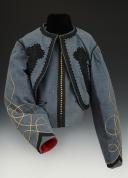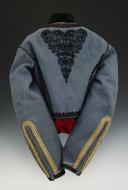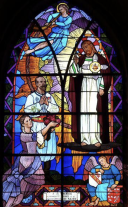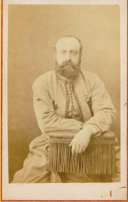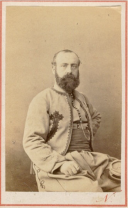
UNIFORM OF PAUL COMTE de SAISY de KERAMPUIL, BATTALION LEADER OF THE PONTIFICAL ZOUAVES, Second Empire, 1868-1870. 27920
Sold out
UNIFORM OF PAUL COMTE de SAISY de KERAMPUIL, SECOND LIEUTENANT OF THE PAPAL ZOUAVES, Second Empire, January 1, 1861 - March 19, 1861. 27929
Jacket in dark sky blue wool with black wool braid trim and scalloped edges. Epaulettes in the same color as the uniform wool edged in a black wool braid topped with a gold and silver braid forming the rank of second lieutenant. The back of the sleeves close with 12 buttonholes adorned with small brass bell buttons (diameter 0.8 cm) framed by a golden silver braid (width 1.2 cm). Back richly decorated with black wool braids. On the left chest of the lining, there is an oval-shaped piece of white wool with scalloped edges and decorated with a sacred Catholic heart in red wool and gold and brown threads in the center (height 6.5 cm, width 5 cm). The inner lining and sleeves are in scarlet canvas.
Vest in dark sky blue wool with black wool braid trim. The front is adorned with 36 brass bell buttons (diameter 0.8 cm). The back is in fine scarlet wool. Fully lined with white canvas. Buttons are made of grey painted metal and bone.
France.
Second Empire, 1868-1870.
The jacket and vest are in superb condition, with the linings showing moth holes, and a top section accident on the back of the vest.
PROVENANCE:
Uniform from the descendants.
THE FAMILY of SAISY de KERAMPUIL, A FAMILY CONNECTED TO THE PAPAL ZOUAVES:
PAUL Césaire Emmanuel Marie Constantin Count de SAISY de KERAMPUIL, born in Kersaint-Éloy (Côtes du Nord) on February 29, 1830. He was a soldier who rose through the ranks from sergeant to lieutenant colonel! He was one of the four battalion leaders of the Papal Zouaves in Rome from 1868 to 1870.
Enlisted in the Franco-Belgian Pontifical Sharpshooters in Rome on June 29, 1860, he served with the rank of sergeant at Castelfidardo. He was appointed second lieutenant on October 1, 1860. Assigned to the Papal Zouaves on January 1, 1861, he was promoted to lieutenant on March 19, 1861, then to captain on June 18, 1861, and to battalion chief on December 27, 1868.
During the war, he was appointed commander in the mobile guard of Finistère in 1870. He was promoted to lieutenant colonel in 1871 and knight of the Legion of Honour in August 1871. He became colonel of the mobiles in Guingamp, then head of the 4th brigade of the Cathelineau division in the Brittany army, and after the war, he commanded, with the rank of lieutenant colonel, the 73rd territorial infantry regiment.
A county councilor, deputy of Finistère (1885-1889), and president of the agricultural committee of Carhaix, he was elected on the conservative list of Finistère in the elections of October 4, 1885; he joined the Union of the Right, opposed the school and colonial policy of the republican government, and voted against the reestablishment of the constituency voting system, for the indefinite postponement of revising the Constitution, against the prosecution of three deputies who were members of the League of Patriots, against the Lisbon law project restricting press freedom, and against the prosecution of General Boulanger.
Paul de Saisy did not run for office again in 1889 and then dedicated himself to the mayorship of Plouguer.
He passed away on April 26, 1894, in Rennes at the age of 65, and was buried on May 1, 1894, in the Carhaix-Plouguer Cemetery, Finistère. The family de Saisy de Kerampuil's grave is located in front of the church.
Campaigns: Marittima and Campagna mobile column in 1860. Ponte Corese incident, 1861. Campaign of 1867. Siege of Rome, 1870. Retreat of Viterbo and siege of Rome. Campaign in France, as lieutenant colonel of the Mobiles in Finistère.
Orders and Decorations: Knight of the Order of Pius IX, Castelfitardo Medal, Mentana and Bene Merenti Medal, Knight of the Legion of Honour.
His brother Count HERVÉ de SAISY de KERAMPUIL was born at the Chateau de Kersaint-Eloy in Glomel (Côtes-du-Nord) on April 5, 1833. Second lieutenant since 1861, in 1863 and 1864 with the Foreign Regiment, he lived for several years in Sidi-Bel-Abbès, participating in the campaigns of Italy and Mexico. He retired as a captain, having served with the Papal Zouaves. His actions in the Papal States led to his being made an officer of the Order of St. Gregory the Great. In 1870, he was the battalion commander of the mobiles, and during the Siege of Paris, he briefly provided protection to Trochu leading the Loudéac mobiles battalion (Côtes-du-Nord).
Knight of the Legion of Honour in February 1871.
A deputy, then Senator.
Accounts from the time described him as a giant of 2.04 meters "capable of loading a barrel of cider onto a cart alone".
On September 20, 1860, Hervé de Saisy married Faustina Ténérani in Rome, daughter of Pietro Ténérani, a sculptor, general director of the Palaces and Museums of Rome, and former Roman senator. They had a daughter, Alix, born in Saint-Brieuc (Côtes-du-Nord) on January 8, 1866.
CHARLES de SAISY de KERAMPUIL (cousin), born in Saint-Pol-de-Léon (Finistère), on October 23, 1846. He joined the Papal Zouaves on October 23, 1867. Sergeant on December 20, 1868. Campaign of 1867, Siege of Rome in 1870. He returned to France in 1870 after the fall of Rome to participate in the fights against the Germans; at 24 years old, he was injured at the Battle of Brou on November 25, 1870, and passed away at Châteaudun hospital on December 4, after having his left leg amputated due to an injury from a shell.
XAVIER de SAISY de KERAMPUIL (cousin), born on February 2, 1843, in Colombey (Meurthe). He was registered in the directory as a simple Zouave on January 31, 1861, a member of the elder branch of the family who, after participating in the 1870 campaign, passed away the same year in Libourne at 27 years old due to war-related causes. He switched to the artillery on November 21, 1861.
HISTORY:
The battalion of the Papal Zouaves, created on January 1, 1861, following the model of the French army's Zouave troops, whose exotic uniforms were very popular in the mid-19th century, became a regiment on January 1, 1867. It was made up of volunteers, mostly French, Belgian, and Dutch, who came to defend the Papal State, threatened by the unification of Italy in favor of Piedmont. Its history is correlated with the last decade of the State of the Holy See (1860-1870). The regiment was disbanded on September 21, 1870, following the disappearance of the Papal States.
The Franco-Belgian Sharpshooters Battalion.
In 1860, the situation of the Papal State seemed critical. The Catholic powers were disinterested, so the Pope's chamberlain, Mgr Xavier de Merode, a former military man who had become the pro-minister of war, called on General de Lamoricière to reorganize and command the papal army. To increase the numbers, Lamoricière resorted to voluntary enlistment and appealed to the Catholic states. Belgians and French formed a battalion of Franco-Belgian sharpshooters (largest contingents coming from Brittany and Vendée) under the command of Viscount Louis de Becdelièvre. He personally wanted to equip them with uniforms inspired by the Zouaves and adapted to the Roman heat. While not well received by Lamoricière, who had other urgent issues, he had the support of Mgr de Merode and the Pope himself; thus, the sharpshooters were already called Papal Zouaves before the official creation of the corps. The Piedmontese defeated the Pontifical troops at the Battle of Castelfidardo (September 18, 1860), leaving the Pope's State reduced to the Latium region. The disaster led to an influx of volunteers to Rome: the Papal Zouaves battalion was formed from a part of the Franco-Belgian sharpshooters and the Irish of St. Patrick's battalion, to which some of Henri de Cathelineau's "crusaders" were added before the battle. Joseph-Louis Guérin, a Nantes seminarian wounded in the fighting, passed away on October 30, 1860. His grave in Nantes became a highly popular pilgrimage site; from 1861 to 1864, it was credited with 35 healing miracles. In May 1860, the Athanase de Charette battalion rallied around General de La Moricière immediately after the expedition to the San-Stefano caves. This operation, led by Colonel de Pimodan, targeted Garibaldi's bands that had invaded the Viterbo province.
On June 1, Mr. de Becdelièvre was appointed battalion leader and designated to take command of the Franco-Belgian Sharpshooters battalion. On June 6, a decree, countersigned by the chief general, organized the first two companies administratively and militarily. On June 18, an out-of-rank section was created. The two companies that weren't immediately formed recruited new volunteers as they arrived, mostly French and Belgians. The Franco-Belgian Sharpshooters battalion settled in Terni for further training; by September 20, 1860, it had an effective strength of 450 men, split into four active companies and one reserve company.
PROPER NOUNS TRANSLATED:
- Netherlands: pays-Bas
- Brittany: Bretagne
- Finistère: a department in France
- Viterbo: a town in Italy
- Carhaix: a commune in France
- Rome: Rome
- Garibaldi: Garibaldi
- Victor-Emmanuel II: Victor-Emmanuel II
- Nantes: Nantes
- La Rochefoucauld-Doudeauville: la Rochefoucauld-Doudeauville
- La Rochefoucauld-Bisaccia: la Rochefoucauld-Bisaccia
- Antibes: Antibes
- Abraham Lincoln: Abraham Lincoln
- General de Lamoricière: General de Lamoricière
- Catholic Church: Église catholique romaine
(Most terms are proper nouns or historical references, and I have translated a few common nouns for context.)
Jacket in dark sky blue wool with black wool braid trim and scalloped edges. Epaulettes in the same color as the uniform wool edged in a black wool braid topped with a gold and silver braid forming the rank of second lieutenant. The back of the sleeves close with 12 buttonholes adorned with small brass bell buttons (diameter 0.8 cm) framed by a golden silver braid (width 1.2 cm). Back richly decorated with black wool braids. On the left chest of the lining, there is an oval-shaped piece of white wool with scalloped edges and decorated with a sacred Catholic heart in red wool and gold and brown threads in the center (height 6.5 cm, width 5 cm). The inner lining and sleeves are in scarlet canvas.
Vest in dark sky blue wool with black wool braid trim. The front is adorned with 36 brass bell buttons (diameter 0.8 cm). The back is in fine scarlet wool. Fully lined with white canvas. Buttons are made of grey painted metal and bone.
France.
Second Empire, 1868-1870.
The jacket and vest are in superb condition, with the linings showing moth holes, and a top section accident on the back of the vest.
PROVENANCE:
Uniform from the descendants.
THE FAMILY of SAISY de KERAMPUIL, A FAMILY CONNECTED TO THE PAPAL ZOUAVES:
PAUL Césaire Emmanuel Marie Constantin Count de SAISY de KERAMPUIL, born in Kersaint-Éloy (Côtes du Nord) on February 29, 1830. He was a soldier who rose through the ranks from sergeant to lieutenant colonel! He was one of the four battalion leaders of the Papal Zouaves in Rome from 1868 to 1870.
Enlisted in the Franco-Belgian Pontifical Sharpshooters in Rome on June 29, 1860, he served with the rank of sergeant at Castelfidardo. He was appointed second lieutenant on October 1, 1860. Assigned to the Papal Zouaves on January 1, 1861, he was promoted to lieutenant on March 19, 1861, then to captain on June 18, 1861, and to battalion chief on December 27, 1868.
During the war, he was appointed commander in the mobile guard of Finistère in 1870. He was promoted to lieutenant colonel in 1871 and knight of the Legion of Honour in August 1871. He became colonel of the mobiles in Guingamp, then head of the 4th brigade of the Cathelineau division in the Brittany army, and after the war, he commanded, with the rank of lieutenant colonel, the 73rd territorial infantry regiment.
A county councilor, deputy of Finistère (1885-1889), and president of the agricultural committee of Carhaix, he was elected on the conservative list of Finistère in the elections of October 4, 1885; he joined the Union of the Right, opposed the school and colonial policy of the republican government, and voted against the reestablishment of the constituency voting system, for the indefinite postponement of revising the Constitution, against the prosecution of three deputies who were members of the League of Patriots, against the Lisbon law project restricting press freedom, and against the prosecution of General Boulanger.
Paul de Saisy did not run for office again in 1889 and then dedicated himself to the mayorship of Plouguer.
He passed away on April 26, 1894, in Rennes at the age of 65, and was buried on May 1, 1894, in the Carhaix-Plouguer Cemetery, Finistère. The family de Saisy de Kerampuil's grave is located in front of the church.
Campaigns: Marittima and Campagna mobile column in 1860. Ponte Corese incident, 1861. Campaign of 1867. Siege of Rome, 1870. Retreat of Viterbo and siege of Rome. Campaign in France, as lieutenant colonel of the Mobiles in Finistère.
Orders and Decorations: Knight of the Order of Pius IX, Castelfitardo Medal, Mentana and Bene Merenti Medal, Knight of the Legion of Honour.
His brother Count HERVÉ de SAISY de KERAMPUIL was born at the Chateau de Kersaint-Eloy in Glomel (Côtes-du-Nord) on April 5, 1833. Second lieutenant since 1861, in 1863 and 1864 with the Foreign Regiment, he lived for several years in Sidi-Bel-Abbès, participating in the campaigns of Italy and Mexico. He retired as a captain, having served with the Papal Zouaves. His actions in the Papal States led to his being made an officer of the Order of St. Gregory the Great. In 1870, he was the battalion commander of the mobiles, and during the Siege of Paris, he briefly provided protection to Trochu leading the Loudéac mobiles battalion (Côtes-du-Nord).
Knight of the Legion of Honour in February 1871.
A deputy, then Senator.
Accounts from the time described him as a giant of 2.04 meters "capable of loading a barrel of cider onto a cart alone".
On September 20, 1860, Hervé de Saisy married Faustina Ténérani in Rome, daughter of Pietro Ténérani, a sculptor, general director of the Palaces and Museums of Rome, and former Roman senator. They had a daughter, Alix, born in Saint-Brieuc (Côtes-du-Nord) on January 8, 1866.
CHARLES de SAISY de KERAMPUIL (cousin), born in Saint-Pol-de-Léon (Finistère), on October 23, 1846. He joined the Papal Zouaves on October 23, 1867. Sergeant on December 20, 1868. Campaign of 1867, Siege of Rome in 1870. He returned to France in 1870 after the fall of Rome to participate in the fights against the Germans; at 24 years old, he was injured at the Battle of Brou on November 25, 1870, and passed away at Châteaudun hospital on December 4, after having his left leg amputated due to an injury from a shell.
XAVIER de SAISY de KERAMPUIL (cousin), born on February 2, 1843, in Colombey (Meurthe). He was registered in the directory as a simple Zouave on January 31, 1861, a member of the elder branch of the family who, after participating in the 1870 campaign, passed away the same year in Libourne at 27 years old due to war-related causes. He switched to the artillery on November 21, 1861.
HISTORY:
The battalion of the Papal Zouaves, created on January 1, 1861, following the model of the French army's Zouave troops, whose exotic uniforms were very popular in the mid-19th century, became a regiment on January 1, 1867. It was made up of volunteers, mostly French, Belgian, and Dutch, who came to defend the Papal State, threatened by the unification of Italy in favor of Piedmont. Its history is correlated with the last decade of the State of the Holy See (1860-1870). The regiment was disbanded on September 21, 1870, following the disappearance of the Papal States.
The Franco-Belgian Sharpshooters Battalion.
In 1860, the situation of the Papal State seemed critical. The Catholic powers were disinterested, so the Pope's chamberlain, Mgr Xavier de Merode, a former military man who had become the pro-minister of war, called on General de Lamoricière to reorganize and command the papal army. To increase the numbers, Lamoricière resorted to voluntary enlistment and appealed to the Catholic states. Belgians and French formed a battalion of Franco-Belgian sharpshooters (largest contingents coming from Brittany and Vendée) under the command of Viscount Louis de Becdelièvre. He personally wanted to equip them with uniforms inspired by the Zouaves and adapted to the Roman heat. While not well received by Lamoricière, who had other urgent issues, he had the support of Mgr de Merode and the Pope himself; thus, the sharpshooters were already called Papal Zouaves before the official creation of the corps. The Piedmontese defeated the Pontifical troops at the Battle of Castelfidardo (September 18, 1860), leaving the Pope's State reduced to the Latium region. The disaster led to an influx of volunteers to Rome: the Papal Zouaves battalion was formed from a part of the Franco-Belgian sharpshooters and the Irish of St. Patrick's battalion, to which some of Henri de Cathelineau's "crusaders" were added before the battle. Joseph-Louis Guérin, a Nantes seminarian wounded in the fighting, passed away on October 30, 1860. His grave in Nantes became a highly popular pilgrimage site; from 1861 to 1864, it was credited with 35 healing miracles. In May 1860, the Athanase de Charette battalion rallied around General de La Moricière immediately after the expedition to the San-Stefano caves. This operation, led by Colonel de Pimodan, targeted Garibaldi's bands that had invaded the Viterbo province.
On June 1, Mr. de Becdelièvre was appointed battalion leader and designated to take command of the Franco-Belgian Sharpshooters battalion. On June 6, a decree, countersigned by the chief general, organized the first two companies administratively and militarily. On June 18, an out-of-rank section was created. The two companies that weren't immediately formed recruited new volunteers as they arrived, mostly French and Belgians. The Franco-Belgian Sharpshooters battalion settled in Terni for further training; by September 20, 1860, it had an effective strength of 450 men, split into four active companies and one reserve company.
PROPER NOUNS TRANSLATED:
- Netherlands: pays-Bas
- Brittany: Bretagne
- Finistère: a department in France
- Viterbo: a town in Italy
- Carhaix: a commune in France
- Rome: Rome
- Garibaldi: Garibaldi
- Victor-Emmanuel II: Victor-Emmanuel II
- Nantes: Nantes
- La Rochefoucauld-Doudeauville: la Rochefoucauld-Doudeauville
- La Rochefoucauld-Bisaccia: la Rochefoucauld-Bisaccia
- Antibes: Antibes
- Abraham Lincoln: Abraham Lincoln
- General de Lamoricière: General de Lamoricière
- Catholic Church: Église catholique romaine
(Most terms are proper nouns or historical references, and I have translated a few common nouns for context.)
Reference :
27929
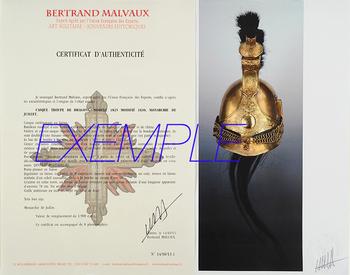
Next update Friday, december 26 at 13:30 PM
FOR ALL PURCHASES, PAYMENT IN MULTIPLE CHECKS POSSIBLE
bertrand.malvaux@wanadoo.fr 06 07 75 74 63
SHIPPING COSTS
Shipping costs are calculated only once per order for one or more items, all shipments are sent via registered mail, as this is the only way to have proof of dispatch and receipt.
For parcels whose value cannot be insured by the Post, shipments are entrusted to DHL or Fedex with real value insured, the service is of high quality but the cost is higher.
RETURN POLICY
Items can be returned within 8 days of receipt. They must be returned by registered mail at the sender's expense, in their original packaging, and in their original condition.
AUTHENTICITY
The selection of items offered on this site allows me to guarantee the authenticity of each piece described here, all items offered are guaranteed to be period and authentic, unless otherwise noted or restricted in the description.
An authenticity certificate of the item including the description published on the site, the period, the sale price, accompanied by one or more color photographs is automatically provided for any item priced over 130 euros. Below this price, each certificate is charged 5 euros.
Only items sold by me are subject to an authenticity certificate, I do not provide any expert reports for items sold by third parties (colleagues or collectors).
FOR ALL PURCHASES, PAYMENT IN MULTIPLE CHECKS POSSIBLE
bertrand.malvaux@wanadoo.fr 06 07 75 74 63
An authenticity certificate of the item including the description published on the site, the period, the sale price, accompanied by one or more color photographs is automatically provided for any item priced over 130 euros. Below this price, each certificate is charged 5 euros.
Only items sold by me are subject to an authenticity certificate, I do not provide any expert reports for items sold by third parties (colleagues or collectors).
